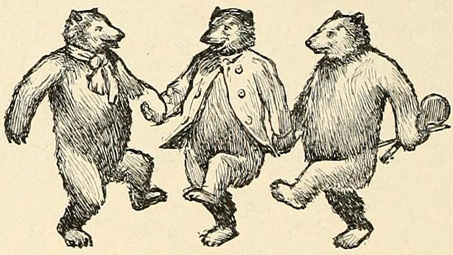The bear that danced by itself

Illustration from the Three Little Bears in St. Nicholas: An Illustrated Magazine for Young Folks from 1897.
This is a story, a true story, of a trapper and a bear; of a phonograph and a dance. If you don’t believe it, journey to Fort Graham post in Northern British Columbia and from there make your way seventy miles into the hinterland until you strike the turbulent, swift-flowing Ingeniha river. Somewhere on the banks of that river you will find “Shorty” Webber’s cabin, and you will also find “Shorty” himself, once a phlegmatic and stolid bushman, now a highly strung, nervous shadow of his former self. Tell “Shorty” that you want to see proofs of his story and he will show you claw marks round the cabin window and door, a smashed phonograph record, and the remains of a once magnificent phonograph.
“Shorty” no doubt will tell you his story; and he’ll begin something like this: “Nobody has to believe it, but I don’t give a ---- anyway. It’s true; I saw it!” And then he’ll tell you how, early in July, he left his cabin securely fastened with boards nailed over the window, because the bears were troublesome that year, and set off on a prospecting trip into the Bower Creek and Fishing Lakes country. He will stress that the night before he left he removed a record from the phonograph and closed the top.
Late in August “Shorty” returned home laden with his winter supplies from Fort Graham post. The river was low, and so he shut off his engine a few hundred yards down stream from his cabin, intending to tow the boat the remaining distance. As the noise of the engine ceased, “Shorty” heard the strains of exhilarating music coming from his cabin, and, thinking that some trapper acquaintance was amusing himself till his return, he set out for the cabin to get the unexpected visitor to give a hand with the boat.
At this point “Shorty’s” story becomes a little, a very little, vague. But can you wonder when you hear what met his wondering gaze as he entered his cabin door? There in the middle of the cabin was a huge grizzly, between eight and ten feet tall, shimmying, shaking and shuffling to the tune of a Swedish polka; and in the best “bear jazz” style, always a swing and a whirl ahead of the music. “Shorty” will tell you how he stood transfixed, watching the dance and listening to the blare of the music from the phonograph.
In the middle of a step the grizzly saw “Shorty” and stopped dead. For a moment man and bear gazed at each other without movement. It was a question which was the more surprised. Suddenly, quick as a flash, the bear’s left paw rose, made a sweeping arc through the air, the top of the phonograph and the record crashed to the floor, and in the next instant the bear had turned and plunged through the two-inch planks which “Shorty” had nailed so carefully over the window to keep the bears out.
That is the story. And now all the bushmen and trailsmen of the country puzzle their heads to decide why the bear smashed the music box. But I know! That bear was a high class professional performer gone “native,” and the knowledge that he had given a free performance was too much for his artistic temperament.
This article originally appeared in the 1934 March issue of The Beaver (now Canada's History magazine).